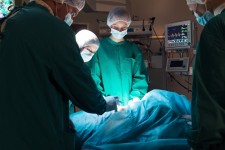Operating rooms in hospitals are often thought of as sterile, germ-free environments but even they are not immune from infection. In fact in some O-Rs, this appears to be the case. According to a first-of-its-kind study, increased comings and goings through the surgical theater is contributing to an increased infection risk for patients.
O-R ventilation systems are designed to maintain elevated (or positive) air pressure. Researchers say every time a door opens, positive pressure forces air out of the room, preventing any potentially hazardous air from entering. But that's not always the case; sometimes air can slip in. What's more, increased foot traffic can also lead to higher bacterial counts in the operating room.
In the recent study, published in the journal Orthopedics, researchers monitored 191 hip and knee surgery procedures at the Johns Hopkins Bayview Medical Center in Baltimore. They found that O-R doors were open roughly 9.5 minutes per procedure, and in nearly half the cases 77 out of 191 positive pressure (sterile air) was defeated, allowing outside air to flow enter the O-R.
Only one of the patients in the study developed an infection after surgery, and the cause of that infection was unknown.
Operating room staff were unaware of the data being collected at the time.
Because they were unaware that the study was being conducted, senior author Stephen Belkoff and colleagues could not ask why the door was open many times. But they say it's likely a common problem nationwide.
"Our findings add to a growing body of evidence of a relatively common practice that could be a potential safety concern," stated Belkoff, from a university news release, "and raises questions about why doors get opened, and how we can prevent or minimize the frequency and duration of behaviors that could compromise OR sterility."
Though much more research is needed, this study raises the question of why so much foot traffic is present during operations, and why doors are excessively opened during that time. The researchers speculate that frequent visits to the outside corridors are needed for supplies, medical equipment, etc., which could signify personnel shortages across the board.




